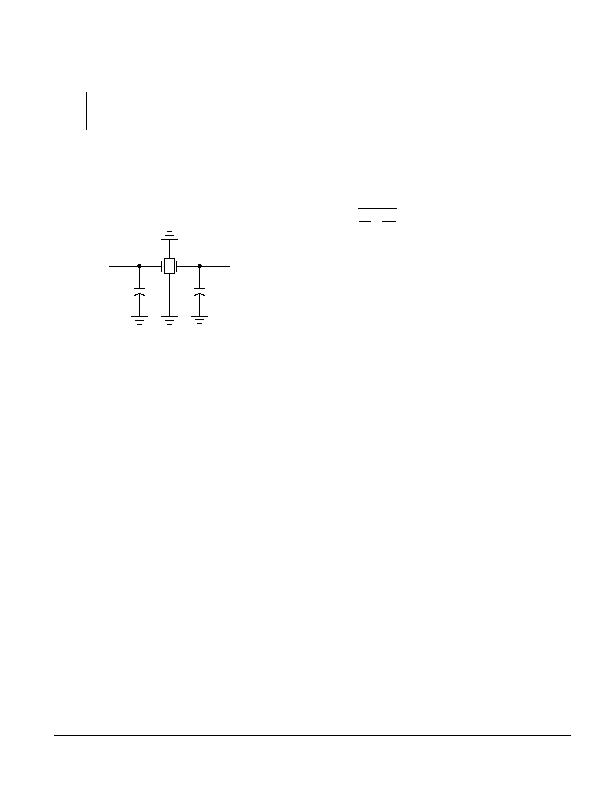
Micrel
MICRF405
April 2006
21
M9999-041906
(408) 955-1690
Crystal Oscillator (XCO)
Adr
Data
A6..A0
D7
D6
D5
D4
D3
D2
D1
D0
0010101 ClkOut_1=0 ClkOut_0=0 XCO_Fast=1 XCOtune4=1 XCOtune3=0 XCOtune2=0
XCOtune1=0
XCOtune0=0
The crystal oscillator is a very critical block. As the
crystal oscillator is a reference for the RF output
frequency, very good phase and frequency stability
is required. When selecting crystal it should be paid
special attention to the total frequency tolerance and
load capacitance as these will directly influence on
the carrier frequency.
C2
C1
XTB, pin 7
XTA, pin 8
Figure 9. Crystal Oscillator Circuit.
The crystal should be connected between pins XTA
and XTB (pin 7 and 8). MICRF405 has an internal
crystal capacitor bank used for crystal tolerance
tuning during production. These internal capacitors
can be enabled using the XCOtune[4:0] bits. If
XCOtune[4:0]=0 then no internal capacitors are
connected to the crystal pins, while 18pF are
connected to each pin if XCOtune[4:0]=31. The unit
capacitance is about 0.6pF. The internal XCOtune
feature is optimized for a crystal with a load
capacitance of 9pF and will give the expected
oscillation frequency when no external capacitors
are connected and XCOtune[4:0]=16. If a crystal
requires higher load capacitance, additional
capacitors must be added off-chip (C1 and C2 in
Figure 9).
If XCOtune[4:0]=0, the loading capacitors can be
calculated by the following formula;
parasitic
L
C
C
C
C
+
+
=
2
1
1
1
1
The parasitic capacitance is the pin input
capacitance and PCB stray capacitance. Typically
the total parasitic capacitance is around 6pF. For
instance, for a 9pF load crystal the recommended
values of the external load capacitors are 5.6pF.
The start-up time of a crystal oscillator is typically
around a millisecond. Therefore, to save current
consumption, the XCO is turned on before any other
circuit block. During start-up the XCO amplitude will
eventually reach a sufficient level to trigger the M-
counter. After counting 2 M-counter output pulses
the rest of the circuit will be turned on. The current
consumption during the prestart period is typically
205礎. If the XCO_Fast bit is set, then XCO will
start up faster, typically in about 300祍. This comes
at the expense of a higher current consumption of
typically 2mA during the period from start up until the
first output pulse of the M-divider.
If an external reference shall be used instead of a
crystal, the signal shall be applied to pin 7, XTB.
Due to internal biasing, AC coupling is
recommended for use between the external
reference and the XTB-pin.
发布紧急采购,3分钟左右您将得到回复。
相关PDF资料
MTX-102-433DR-B
MODULE TRANSMITTER 433MHZ 18DIP
MTX-103-915DR-B
MODULE TRANSMITTER 915MHZ 18DIP
MTX-405-433DR-B
MODULE TRANSMITTER 433MHZ 24DIP
N50P105
IC MODULE MINI JOYSTICK SMD
OCB350L187Z
BOARD CALIBR CIRCUIT OPB350L187
OMB.242.08F21
OMNI OUTDOOR ANTENNA
OMNILOG90200
ANTENNA ISOTRP 700MHZ-2.5GHZ RAD
OPR5011
COMPARATOR OPTICAL 3 CHAN SMD
相关代理商/技术参数
MICRF405YML-TR
功能描述:RF Transmitter ASK, FSK 290MHz ~ 980MHz 10dBm 200kbps PCB, Surface Mount Antenna 24-VFQFN Exposed Pad, 24-MLF? 制造商:microchip technology 系列:- 包装:剪切带(CT) 零件状态:停产 频率:290MHz ~ 980MHz 应用:ISM 调制或协议:ASK,FSK 数据速率(最大值):200kbps 功率 - 输出:10dBm 电流 - 传输:18mA 数据接口:PCB,表面贴装 天线连接器:PCB,表面贴装 存储容量:- 特性:* 电压 - 电源:2.2 V ~ 3.6 V 工作温度:-40°C ~ 125°C 封装/外壳:24-VFQFN 裸露焊盘,24-MLF? 标准包装:1
MICRF500
制造商:MICREL 制造商全称:Micrel Semiconductor 功能描述:700MHz to 1.1GHz RadioWire RF Transceiver
MICRF500BLQ
制造商:MICREL 制造商全称:Micrel Semiconductor 功能描述:700MHz to 1.1GHz RadioWire RF Transceiver
MICRF500BLQ TR
功能描述:射频接收器 700-1000MHz, 3.0V, FSK, FH Transceiver
RoHS:否 制造商:Skyworks Solutions, Inc. 类型:GPS Receiver 封装 / 箱体:QFN-24 工作频率:4.092 MHz 工作电源电压:3.3 V 封装:Reel
MICRF500BLQTR
功能描述:TXRX UHF 700-1100MHZ 44-LQFP RoHS:否 类别:RF/IF 和 RFID >> RF 收发器 系列:- 产品培训模块:Lead (SnPb) Finish for COTS
Obsolescence Mitigation Program 标准包装:30 系列:- 频率:4.9GHz ~ 5.9GHz 数据传输率 - 最大:54Mbps 调制或协议:* 应用:* 功率 - 输出:-3dBm 灵敏度:- 电源电压:2.7 V ~ 3.6 V 电流 - 接收:* 电流 - 传输:* 数据接口:PCB,表面贴装 存储容量:- 天线连接器:PCB,表面贴装 工作温度:-25°C ~ 85°C 封装/外壳:68-TQFN 裸露焊盘 包装:管件
MICRF500EVAL1
功能描述:射频开发工具 MICRF500 Evaluation Kit - For experimental use only
RoHS:否 制造商:Taiyo Yuden 产品:Wireless Modules 类型:Wireless Audio 工具用于评估:WYSAAVDX7 频率: 工作电源电压:3.4 V to 5.5 V
MICRF501
制造商:MICREL 制造商全称:Micrel Semiconductor 功能描述:300MHz to 600MHz RadioWire⑩ RF Transceiver
MICRF501BLQ
制造商:Rochester Electronics LLC 功能描述:- Bulk 制造商:RF Micro Devices Inc 功能描述: